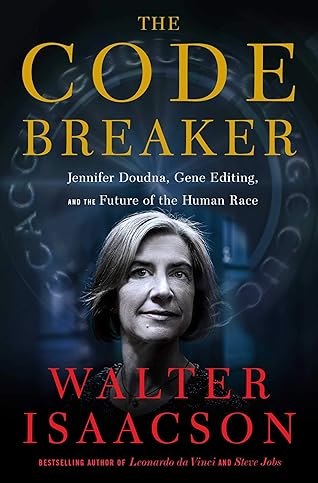More on this book
Community
Kindle Notes & Highlights
Read between
April 16 - April 24, 2022
virus-fighting trick used by bacteria, which have been battling viruses for more than a billion years. In their DNA, bacteria develop clustered repeated sequences, known as CRISPRs, that can remember and then destroy viruses that attack them. In other words, it’s an immune system that can
will that greatly increase inequality—and
RNA. It’s the molecule that actually does the work in a cell by copying some of the instructions coded by the DNA and using them to build proteins.
Doudna’s career would be shaped by the insight that is at the core of The Double Helix: the shape and structure of a chemical molecule determine what biological role it can play.
Thomas Malthus, an English economist. Malthus argued that the human population was likely to grow faster than the food supply. The resulting overpopulation would lead to famine that would weed
What was the mechanism?
Gregor Mendel,
His performance on one biology exam was especially dreadful.
There was no blending of traits. Tall plants cross-bred with short ones did not produce medium-size offspring,
recessive trait reappeared in the next generation.
The findings of Mendel and these subsequent scientists led to the concept of a unit of heredity,
nucleic acids, that are the workhorses of heredity.
Salvador Luria.
The easiest of these viruses to study are the ones that attack bacteria, and they were dubbed (remember the term, for it will reappear when we discuss the discovery of CRISPR) “phages,” which was short for “bacteriophages,” meaning bacteria-eaters.
Although Watson and Crick had not exactly stolen Franklin’s findings, they had appropriated her work without her permission.
pretty good idea of DNA’s structure. It had two sugar-phosphate strands that twisted and spiraled to form a double-stranded helix.
the four bases in DNA: adenine, thymine, guanin...
This highlight has been truncated due to consecutive passage length restrictions.
adenine would attract thymine and guanine would attract cytosine.
“It has not escaped our notice that the specific pairing we have postulated immediately suggests a possible copying mechanism for the genetic material.”
She had made a tool that could edit the genes of yeast.
Doudna’s childhood hero James Watson
phages
Nature, not nurture, made Rufus the way he was, and it also made different groups of people the way they were. Or so it appeared to Watson, who saw things through glasses filtered by his DNA discovery and his son’s condition.
Craig Venter,
The men who had sequenced DNA taught us how to read the code of life, but the more important step would be learning how to write that code. This would require a different set of tools, ones that would involve the worker-bee molecule that Doudna found more interesting than DNA.
DNA
Its primary activity is protecting the information it encodes
CRISPR
There this “messenger RNA” facilitates the assembly of the proper sequence of amino acids to make a specified protein.
Fibrous proteins,
Membrane proteins relay signals within cells.
enzymes.
Almost every action that takes place in a cell needs to be catalyzed by an enzyme.
information moving from DNA to RNA to the building of proteins. He dubbed it the “central dogma”
“ribozymes,”
introns
certain RNAs had the catalytic powers of enzymes.
RNA was treated as this dull intermediary, sort of a middle manager,”
ribozyme
“This reaction demonstrates the feasibility of RNA-catalyzed RNA replications,” she and Szostak wrote in a 1998 paper for Nature.
She knew that God was in the details but also in the big picture.
structural biology.
structural biologists try to discover the three-dimensional shape of molecules.
how some RNA molecules could reproduce themselves.
figure out the folds and twists of the three-dimensional structure of self-splicing RNA. She was aware that such work would be an echo of that done by Franklin on DNA, and the parallel pleased her. “She
ribozyme,
introns.”
how its twists and folds could bring the right atoms together to cause chemical reactions and allow the snippet of RNA to replicate
“Dicer.” Dicer
researchers hoped to find ways to use RNA interference to protect humans from infections.


